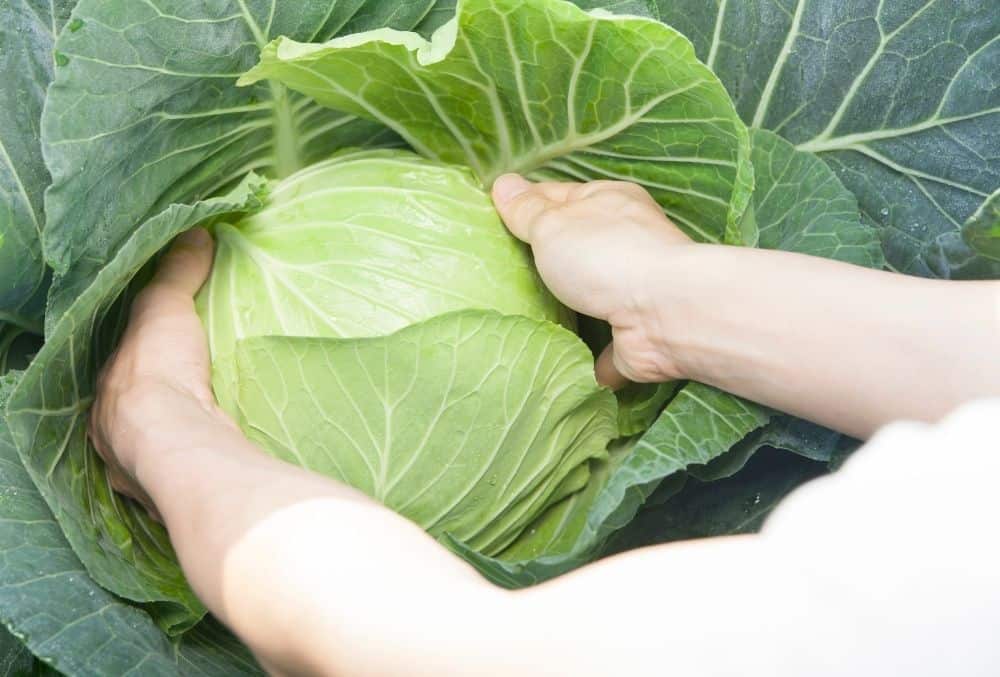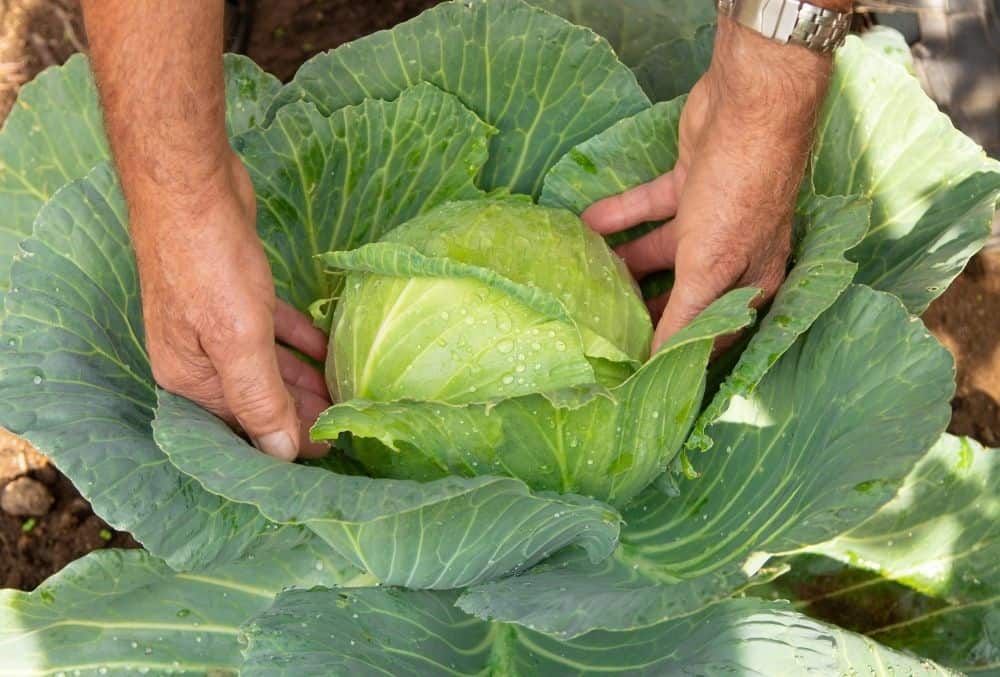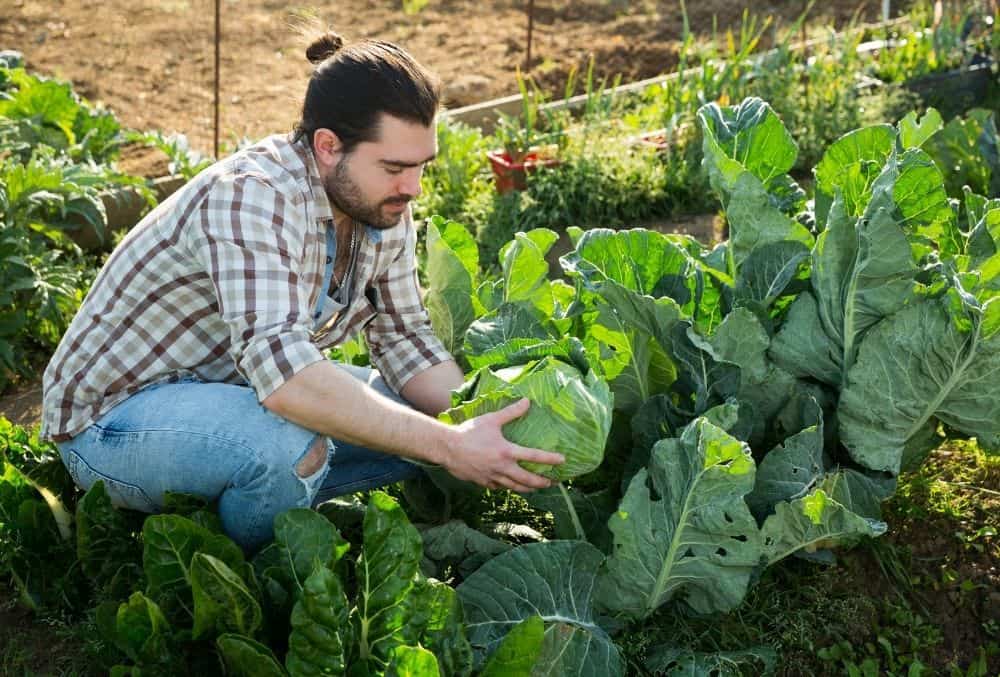Understanding how and when to harvest cabbage is one of the most helpful things you can learn for any happy homestead.
Cabbage is a very versatile vegetable which is incredibly nutritious. It’s packed with vitamins like A, B6 and C and is very fibrous. A real help when it comes to making a balanced, healthy diet.

It can be difficult to know though, when exactly is the right time to harvest cabbage? How will you know?
Don’t worry – we can help you with a useful look into the world of cabbage. So, get comfortable and read on… when to harvest cabbage.
When Is The Right Time?
This will really depend on the type of cabbage you’ve planted as the maturity will alter.You can not tell the maturity of a cabbage head by size – it’s all about the firmness and solidity of the heads.
When you hold the cabbage and squeeze it, you can tell if it is ready to harvest if the head is solid and firm all the way through. It isn’t easy to say exactly when your cabbage will be ready in terms of giving a time frame, as factors can wildly change the duration of maturity.
These include weather conditions, the quality of the soil it is grown in and the variety of cabbage it is. Typically though, you can expect to see a mature cabbage within 70 days.
How To Harvest Cabbage
After you’ve established that the cabbage is ready for harvest, you can now do so. You’ll want to cut the cabbage heads individually from the base using a sharp blade.
Ensure that you’re removing any yellow leaves (these can go into your compost heap). If there are any loose green leaves – you can use these later when storing the cabbages. Once the cabbage has been harvested, bring them indoors as soon as possible and keep them shaded.
Always inspect your cabbage for any signs of infestation from pests or any diseases. These can include cabbage worms, black rot, stink bugs and cabbage root maggots.

Signs of these will differ depending on the culprit, but you may notice things such as black leaves, strange looking liquids on the leaves and multiple holes in the leaves.
If your crops do have infestation, do not put these into compost. Unfortunately, they are not good for any use so they must be destroyed.
Storing Your Cabbage
Depending on what sort of storage capacity/capability you have, you can have your cabbages stored from days to months.
If you’re refrigerating your cabbages, ensure you have a dry cabbage and wrap it in plastic (but not too tightly!). Typically, you can expect cabbage to last around 14 days in a refrigerator like this. However, if you have a root cellar – you could keep your cabbages in storage for around 3 months!
Regrowing Your Cabbage
Avoiding soil diseases is key to having a good cabbage crop. Correct crop rotation will help here. Ensure you’re planting in the desired soil temperature which is around 65 degrees fahrenheit.
If you know there is going to be cold weather incoming, it is worth covering your cabbages with plastic sheeting to avoid the cabbages having loose heads.
Every week you’ll want to water the crops with at least 2 inches of water per square foot. When it comes to fertilization, you’ll want to first use a balanced fertilizer around 2 weeks after transplanting.
3 weeks after this, it is wise to use a fertilizer which is full of nitrogen – this is important in the early days of cabbage growth.
It’s important to remember that the closer you plant your cabbages to each other, the smaller the heads will be, so plan in advance when choosing your spots to grow them.
Ensure your soil has good drainage – if the roots of cabbages remain in water for too long, the heads may rot. It’s a good idea to prepare your soil by mixing the soil with compost and/or manure.
Why Grow Cabbage Anyway?

There are so many benefits to growing cabbage! Some of the top reasons to grow cabbage are:
- Cabbage can be an excellent source of food for both humans and animals on a lively homestead. It’s fibrous, packed full of vitamins, minerals and protein and acts as an antioxidant.
- Cabbage is relatively inexpensive to maintain and continue growing and it doesn’t require as much attention as some other crops.
- You can grow cabbage at any time of the year, but certain times are more recommended than others (depending on where you live!) Either way, you’re not restricted as you may be with some other crops.
- Cabbage is very versatile which is fantastic for meals. If you’ve harvested a particularly large amount of cabbage, you can create numerous types of meal ideas which can often be frozen and enjoyed at your own discretion. Meal or snack ideas include salads, soups, stews, coleslaws, curries, broths and stir-frys.
- Cabbage can keep for longer than most other vegetables. Cabbages can remain refrigerated for a while, making it ideal for a self-sufficient lifestyle. Using some of the meal ideas, you can keep stocked up for quite some time!
- The health benefits are massive. It is incredibly low in calories (making it an ideal food source for weight loss or weight management) and due to its antioxidant properties, it can improve the appearance of your skin.
What To Remember
So, although it isn’t necessarily straightforward to say a time period for when cabbages are ready for harvest – you can expect results within the first 70 days but it is always worth keeping an eye on your cabbage growth using the firmness test method.
Growing your own cabbage is a great source of food for you and livestock (if you have any) and has plenty of its own benefits. The more you grow your own crops, the better your understanding will be when the next crops are ready for harvest!
